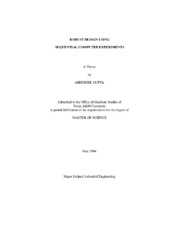Robust design using sequential computer experiments
| dc.contributor.advisor | Ding, Yu | |
| dc.creator | Gupta, Abhishek | |
| dc.date.accessioned | 2004-09-30T02:05:06Z | |
| dc.date.available | 2004-09-30T02:05:06Z | |
| dc.date.created | 2005-05 | |
| dc.date.issued | 2004-09-30 | |
| dc.identifier.uri | https://hdl.handle.net/1969.1/492 | |
| dc.description.abstract | Modern engineering design tends to use computer simulations such as Finite Element Analysis (FEA) to replace physical experiments when evaluating a quality response, e.g., the stress level in a phone packaging process. The use of computer models has certain advantages over running physical experiments, such as being cost effective, easy to try out different design alternatives, and having greater impact on product design. However, due to the complexity of FEA codes, it could be computationally expensive to calculate the quality response function over a large number of combinations of design and environmental factors. Traditional experimental design and response surface methodology, which were developed for physical experiments with the presence of random errors, are not very effective in dealing with deterministic FEA simulation outputs. In this thesis, we will utilize a spatial statistical method (i.e., Kriging model) for analyzing deterministic computer simulation-based experiments. Subsequently, we will devise a sequential strategy, which allows us to explore the whole response surface in an efficient way. The overall number of computer experiments will be remarkably reduced compared with the traditional response surface methodology. The proposed methodology is illustrated using an electronic packaging example. | en |
| dc.format.extent | 590304 bytes | en |
| dc.format.extent | 55991 bytes | en |
| dc.format.medium | electronic | en |
| dc.format.mimetype | application/pdf | |
| dc.format.mimetype | text/plain | |
| dc.language.iso | en_US | |
| dc.publisher | Texas A&M University | |
| dc.subject | design of computer experiments | en |
| dc.subject | sequential design | en |
| dc.subject | robust design | en |
| dc.subject | kriging | en |
| dc.subject | metamodel | en |
| dc.subject | Finite Element Analysis | en |
| dc.subject | response surface methodology | en |
| dc.title | Robust design using sequential computer experiments | en |
| dc.type | Book | en |
| dc.type | Thesis | en |
| thesis.degree.department | Industrial Engineering | en |
| thesis.degree.discipline | Industrial Engineering | en |
| thesis.degree.grantor | Texas A&M University | en |
| thesis.degree.name | Master of Science | en |
| thesis.degree.level | Masters | en |
| dc.contributor.committeeMember | Garcia-Diaz, Alberto | |
| dc.contributor.committeeMember | Ringer, Larry J. | |
| dc.type.genre | Electronic Thesis | en |
| dc.type.material | text | en |
| dc.format.digitalOrigin | born digital | en |
Files in this item
This item appears in the following Collection(s)
-
Electronic Theses, Dissertations, and Records of Study (2002– )
Texas A&M University Theses, Dissertations, and Records of Study (2002– )


